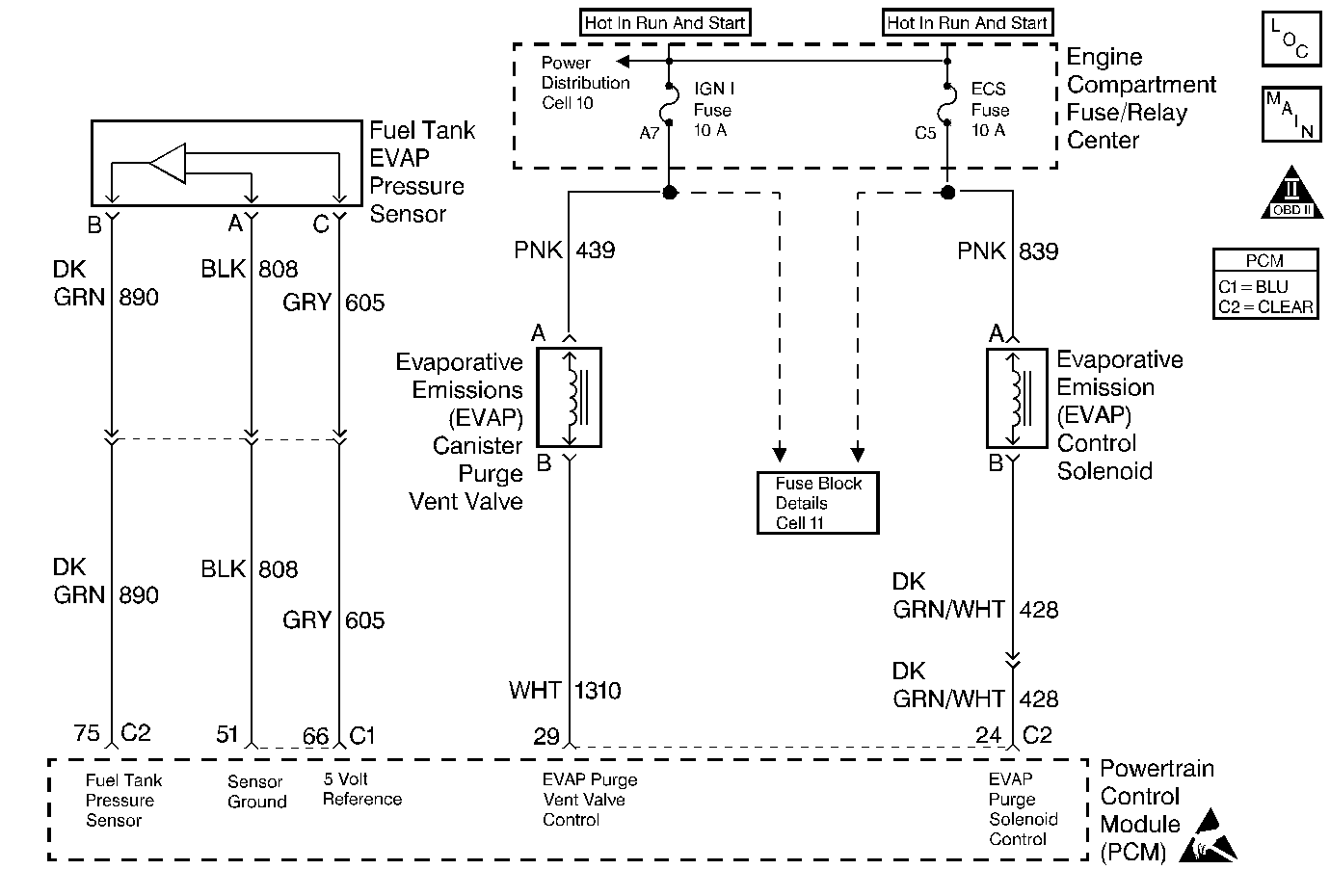
Circuit Description
The PCM tests the EVAP system for the following conditions:
| • | Large and small leaks (P0440 and P0442) |
| • | Excess vacuum (P0446) |
| • | Purge flow during non-commanded conditions (P1441) |
| • | Fuel Tank Pressure sensor and Fuel Level sensor faults (P0452, P0453, P0461, P0462 and P0463) |
| • | EVAP Purge and Vent Valve faults (P1645 and P1646) |
The PCM monitors the amount of vacuum in the EVAP system by monitoring the Fuel Tank Pressure sensor. For this DTC the PCM turns OFF the EVAP Purge Valve and turns ON the EVAP Vent Valve when the Conditions for Running the DTC have been met. This test indicates a leaking EVAP Purge Valve or Flow During Non-Purge if the Fuel Tank Pressure sensor indicates increasing fuel tank vacuum. This DTC will set after two consecutive failures of the above test.
Conditions for Running the DTC
| • | DTC's P0107, P0108, P0112, P0113, P0117, P0118, P0122, P0123, P0125, P0131, P0132, P0133, P0134, P0135, P0141, P0151, P0152, P0153, P0154, P0452, P0453, P0503, P1111, P1112, P1114, P1115, P1133 or P1153 are not set. |
| • | Battery voltage is between 10.5 and 17.5 volts. |
| • | Barometric pressure is more than 71.78 kPa. |
| • | Fuel level is between 10% and 89.8% of full capacity for at least 3.2 seconds continuously. The time limit is required because fuel sloshing within the tank may cause the fuel level indication to vary outside the fuel level limits. |
| • | Coolant temperature is between 2°C and 32.7°C. |
| • | Intake air temperature is between 2°C and 32.7°C |
| • | Start up coolant and intake air temperature are within 14.2°C of each other. |
Conditions for Setting the DTC
An increasing vacuum in the EVAP system is monitored.
Important: This DTC does NOT report a first failed test. A first fail of this DTC will have a scan tool status as Not Run. Use the scan tool data display parameter of EVAP TEST RESULT to determine if this DTC has failed or passed for THIS ignition cycle.
Action Taken When the DTC Sets
| • | The PCM will illuminate the Malfunction Indicator Lamp (MIL) after two consecutive drive trips that the diagnostic runs and fails. |
| • | The PCM will record operating conditions at the time the DTC sets. This information will be stored in the Freeze Frame and Failure Records. |
| • | A first failure of this DTC will NOT store in Last Test Failed or History. |
Conditions for Clearing the MIL/DTC
| • | The PCM will turn the MIL OFF after three consecutive drive trips that the diagnostic runs and does not fail. |
| • | A Last Test Failed DTC will clear when the diagnostic runs and does not fail. |
| • | A History DTC will clear after forty consecutive warm-up cycles with no failures of any diagnostic test. |
| • | PCM battery voltage is interrupted. |
| • | Using a Scan tool. |
Diagnostic Aids
Important: An accurate indication of fuel level is required for the PCM to properly Pass or Fail this DTC. Always diagnose fuel level sensor DTCs before performing this DTCs diagnostic table. Always check for fuel level sensor DTCs stored as History.
Perform a physical inspection of the EVAP system. Check for the following conditions:
| • | Incorrectly routed or defective EVAP system vacuum and vapor lines. |
| • | A stuck open EVAP Purge Valve. |
| • | A malfunctioning or damaged vapor canister |
Check for charcoal release from the vapor canister. Refer to the Evaporative Emission System Cleaning .
The vacuum and pressure in the EVAP system is measured in inches of water (H2O). Most gauges measure vacuum in inches of mercury (Hg) and pressure in pounds per square inch (psi). The following shows how the values compare:
in H2O | in Hg | psi |
|---|---|---|
1in H2O | 0.07 in Hg | 0.0361 psi |
5 in H2O | 0.36 in Hg | 0.180 psi |
10 in H2O | 0.73 in Hg | 0.361 psi |
15 in H2O | 1.10 in Hg | 0.541 psi |
Test Description
Number(s) below refer to the step number(s) on the Diagnostic Table.
Step | Action | Value(s) | Yes | No |
|---|---|---|---|---|
1 | Did you perform the Powertrain On-Board Diagnostic (OBD) System Check? | -- | Go to Step 2 | |
2 | Is DTC P1645 stored as History? | -- | Go to DTC P1645 EVAP Solenoid Output Circuit | Go to Step 3 |
Does the vacuum gauge ever indicate vacuum? | -- | Go to Step 4 | Fault not present. Refer to Diagnostic Aids | |
4 |
Important: Check for carbon contamination. Refer to Diagnostic Aids. Replace the EVAP Purge Solenoid Valve. Is the replacement complete? | -- | -- |
